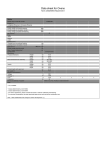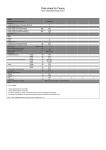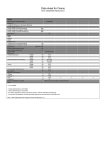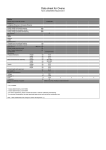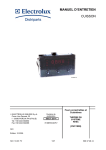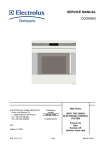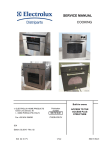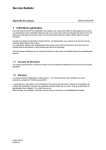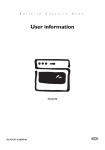Download SERVICE MANUAL COOKING
Transcript
SERVICE MANUAL COOKING Built-in appliances and floor-mounted stoves with „Perfect 2“ input electronics © Electrolux Distriparts Muggenhofer Straße 135 D-90429 Nürnberg Germany Fax +49 (0)911 323 1022 DGS-TDS-N 05.09 Edition: Publ.-Nr.: 599 518 772 685 EN Table of contents 1. ESD=electrostatic discharge ................................................................................................. 3 2. 2.1 2.2 2.3 2.3.1 2.3.2 Software specifications, Functions ........................................................................................ 4 Illustration of the input electronics (UI) Perfect2 ..................................................................... 4 Button / and display layouts of all appliance groups, countries and brand ............................. 4 Main features of operation ...................................................................................................... 6 Clock setting following network reset ..................................................................................... 6 Electronic child-safe function ................................................................................................. 6 3. 3.1 3.2 3.3 3.4 3.5 Functions of appliance ........................................................................................................... 7 Oven functions, capacities and small consumer - appliance-specific .................................. 7 Pyrolitical cleaning - Explanation .......................................................................................... 13 High-speed heating - Explanation ......................................................................................... 14 Safety function safety cutoff of oven ..................................................................................... 15 Safety function safety cutoff of cooking zones ..................................................................... 15 4. 4.1 4.1.1 4.1.2 4.1.2.1 4.1.2.2 4.1.3 4.1.4 4.1.4.1 4.1.4.2 4.1.5 4.1.6 4.2 4.2.1 4.2.2 4.2.3 Functional parts - Component data, installation situation, dismantling ................................. 16 Functional parts - Oven control ............................................................................................ 16 Input electronic (UI) Perfect2 ................................................................................................ 16 Power electronics ................................................................................................................ 17 Power electronic OVC2000 .................................................................................................. 17 Prisma power electronic ...................................................................................................... 18 Temperatursensor PT500 .................................................................................................... 19 Door locking systems ........................................................................................................... 20 Door locking system, standard ............................................................................................. 20 Door locking system, motorics with door-switch light .......................................................... 22 Door switch for the light ........................................................................................................ 22 Light bar in the control panel ................................................................................................ 23 Functional parts - Cooking setting control ............................................................................ 24 Power controller ................................................................................................................... 24 Input electronic HOC2000 and Input module ........................................................................ 25 cooking zone power board HOC2000 .................................................................................. 27 5. 5.1 5.2 5.3 5.4 Technical equipment ............................................................................................................ 29 Temperature safety device ................................................................................................... 29 Fan after-running .................................................................................................................. 29 Measure against wrong electrical connection ...................................................................... 30 Oven rack protective circuit .................................................................................................. 30 6. 6.1 6.2 6.3 6.3.1 6.3.2 6.4 Fault diagnosis/ What to do if ...? ......................................................................................... 31 Alarmmanagement (Faultcodes) .......................................................................................... 31 Measuring the temperature sensor ...................................................................................... 32 Demo Mode input electronic Perfect 2 ................................................................................. 33 Activating/deactivating Version a .......................................................................................... 33 Activating/deactivating Version b .......................................................................................... 34 Door lock test ....................................................................................................................... 35 7. 7.1 7.2 7.3 7.4 7.5 7.6 7.7 Wiring diagram / measuring points ...................................................................................... 36 Connection Point Overview .................................................................................................. 36 Example circuit diagram OVC 1000 ..................................................................................... 37 Example circuit diagram OVC 2000 ..................................................................................... 38 Example circuit diagram SOEC ........................................................................................... 39 Example circuit diagram Prisma .......................................................................................... 40 Example circuit diagram HOC 2000 ..................................................................................... 41 Operative Equipment Overview ............................................................................................ 42 Changes ............................................................................................................................................. 43 DGS-TDS-N 05.09 A. B. © Electrolux -2- 599 518 772 EN 1. ESD=electrostatic discharge As the single electronic interfaces are not protected internally against statical electricity and are partially open, you must pay attention to that, in case of a repair, there will be a potential compensation via the housing of the appliance (touch it) in order to neutralize a possible charging and to prevent a damaging of the affected electronic interface. You also have to be careful with those electronics delivered as spare parts, which have to be put out of the ESD protective package only after a potential compensation (discharge of possible statical electricity). If a potential compensation with an existing static electricity is not executed, it does not mean that the electronic is demaged directly. Consequential damages may result due to the damaging of internal structures which arise only in case of load through temperature and current. Endangered are all assembly groups which are provided with control entries, wire paths lying open and free-accessible processors. DGS-TDS-N 05.09 A. B. © Electrolux -3- 599 518 772 EN 2. Software specifications, Functions 2.1 Illustration of the input electronics (UI) Perfect2 Fig.: UI for power electronic Fig.: UI with Prisma power electronic 2.2 Button / and display layouts of all appliance groups, countries and brand - Display layout for fitted and floor-mounted AEG appliances in Germany - Button layouts of all appliance groups, countries and brand AEG in Germany 1 Key 1 Key 2 and 3 Key 4 Key 5 and 6 Key 7 2 - 3 4 5 6 7 Main Button Selection button - oven functions vorwärts/rückwärts Selection button - Quick Heating Minus/Plus (e.g., clock, meat thermometer, etc.) Selection button MODE (e.g., clock, meat thermometer, etc.) DGS-TDS-N 05.09 A. B. © Electrolux -4- 599 518 772 EN - Display layout for fitted and floor-mounted AEG and Electrolux appliances Keylayout Cavity - Single Button layout for all appliance groups A 1 - 2 3 4 5 6 Double Cavity Button layout oven A 8 - 7 Button layout for all appliance groups B 9 - 7 10 Double Cavity Button layout oven B 7 Key 1 Key 2 and 3 Key 4 Key 5 and 6 Key 7 Key 8 Key 9 Key 10 - Main Button Selection button - oven functions vorwärts/rückwärts Selection button - Quick Heating Minus/Plus (e.g., clock, meat thermometer, etc.) Selection button MODE (e.g., clock) Selection button double Oven Selection button meat thermometer Selection button MODE (e.g., clock) DGS-TDS-N 05.09 A. B. © Electrolux -5- 599 518 772 EN 2.3 Main features of operation 2.3.1 Clock setting following network reset Information: The oven only functions with set time! When the appliance must be connected again with the mains e.g. after a repair, you have to set the clock anew. Proceed as follows: a) b) c) Following connection or a power loss and depending on the display class, either the symbol for the time of day blinks or the arrow in front of the the ‘time of day’ symbol blinks. With the +/- buttons, it can also be a separate component when necessary (input module) to set the time of day. If need be, confirm with the MODE button (=Timer button) The appliance is ready for operation. 2.3.2 Electronic child-safe function Basic prerequisites: - Power supply voltage is connected No oven function selected. If the appliance is equipped with a Main Switch, then this must be activated To activate and deactivate the child-safety function, the MODE button (=Timer button) must be activated together with the „„Minus“ button, or, with appliances featuring a Temperature Selection Switch, this must be put into the „Minus“ position when activating the MODE button (=Timer button). Caution: the child-proof lock remains activated even when there is a voltage drop. Additional important information on this subject is included in Chapter 3.6 "Special instructions on hob/oven communication in floor-mounted appliances". DGS-TDS-N 05.09 A. B. © Electrolux -6- 599 518 772 EN 3. Functions of appliance 3.1 Oven functions, capacities and small consumer - appliance-specific Brand / Market: AEG (Nexxxt) Germany + AEG (Nexxxt) Export Oven class w ithout pyrolytical cleaning Electronic: OVC2000 heating elements (Watt) oven function suggested temperature Boost Pos.0 (Appliance switched off) Pos.1 150 B Pos.2 200 A Pos.3 120/80 Pos.4 (top-/bottom el.) 200 B Pos.5 180 A Pos.6 300 Pos.7 300 Pos.8 (keep warm) 80 Pos.9 30 Pos.10 150 - Manual booster Manual booster grill element 1900 A B X X X - X X X X X - X X X X X X X X X X X X X X X X X X X X X X X X X X X X X 3030 3030 3030 2090 3030 2990 1990 2090 105 1090 13,2 13,2 13,2 9,1 13,2 13,0 8,7 9,1 0,5 4,7 X X - X X - X X X X X X X X 3030 3030 13,2 13,2 w ith pyrolytical cleaning Electronic: OVC2000 150 200 120/80 200 180 300 300 80 30 150 B A B A - 2 d ifferent running times - Manual booster Manual booster Brand / Mar ket: AEG Export France Oven class w ithout pyrolytical cleaning Electr onic: OVC2000 oven function Pos.0 (Appliance switched off) Pos.1 Pos.2 Pos.3 Pos.4 (top-/bottom el.) Pos.5 Pos.6 Pos.7 Pos.8 (keep warm) Pos.9 Pos.10 Manual booster Manual booster Manual booster grill element 1900 A B current ampere (W) X X X X X X AEG (Nexxxt) Germany + AEG (Nexxxt) Export Boost Power (W) X X X X X X - Oven class suggested temperature oven lamp side wall 25 X X X - Brand / Market: oven function Pos.0 (Appliance switched off) Pos.1 Pos.2 Pos.3 Pos.4 (top-/bottom el.) Pos.5 Pos.6 Pos.7 Pos.8 (keep warm) Pos.9 Pos.10 Pos.11 (Pyro) small loads (Watt) oven lamp back wall 40 top element bottom element rear element cooking fan cooling fan 40 25 1000 1000 1900 heating elements (Watt) bottom top element element rear element cooking fan cooling fan 40 25 1000 1000 1900 small loads (Watt) oven lamp back oven lamp side wall wall 40 25 door lock Power (W) 5 current ampere (W) X X X X X X X X X X X X X X X X X X X X X - X X X X X X X X X X X X X X X X X X X X X X X X X X - X X X X X X X X X X - X 3030 3030 3030 2090 3030 2990 1990 2090 105 1090 2930 13,2 13,2 13,2 9,1 13,2 13,0 8,7 9,1 0,5 4,7 12,7 X X - X X - X X X X X X X X - 3030 3030 13,2 13,2 heating elements (Watt) bottom top element element rear element cooking fan cooling fan 40 25 1000 1000 1900 small loads (Watt) oven lamp back oven lamp side wall wall 40 25 Motor current ampere Grillspieß Power (W) (W) 5 suggested temperature Boost grill element 1900 150 200 120/80 200 180 300 300 80 30 150 B A B C - X X X - X X X X X X - X X X X X X X X X - X X X X X - X X X X X X X X X X X X X X X X X X X X X X X X X X X X X X X X - 3030 3030 3030 2090 3035 2995 1995 2090 105 1090 13,2 13,2 13,2 9,1 13,2 13,0 8,7 9,1 0,5 4,7 X - X X X - X X X X X X X X X X X X X X X 3030 3030 3035 13,2 13,2 13,2 A B C DGS-TDS-N 05.09 A. B. © Electrolux -7- 599 518 772 EN Brand / Market: AEG Export France Oven class w ith pyrolytical cleaning Electronic: OVC2000 oven function Pos.0 (Appliance switched off) Pos.1 Pos.2 Pos.3 Pos.4 (top-/bottom el.) Pos.5 Pos.6 Pos.7 Pos.8 (keep warm) Pos.9 Pos.10 Pos.11 (Pyro) suggested temperature Boost 150 200 120/80 200 180 300 300 80 30 150 B A B C - 2 dif ferent running t imes - Manual booster Manual booster Manual booster grill element 1900 A B C heating elements (Watt) bottom top element element rear element cooking fan cooling fan 1000 1000 1900 40 25 Motor current ampere Grillspieß door lock Power (W) (W) 5 5 X X X X X X X X X X X X X X X X X X X X X - X X X X X X X X X X X X X X X X X X X X X X X X X X - X X X X X X X X X X - X X X - X 3030 3030 3030 2090 3035 2995 1995 2090 105 1090 2930 13,2 13,2 13,2 9,1 13,2 13,0 8,7 9,1 0,5 4,7 12,7 X - X X X - X X X X X X X X X X X X X X X - 3030 3030 3035 13,2 13,2 13,2 Brand / Market: AEG (Nexxxt) UK Oven class Double oven w ithout pyrolytical cleaning Electronic: OVC2000 Main oven oven function Pos.0 (Appliance switched off) Pos.1 (lighting) Pos.2 Pos.3 Pos.4 Pos.5 Pos.6 (top-/bottom el.) Pos.7 Pos.8 Pos.9 Pos.10 (keep warm) small loads (Watt) oven lamp back oven lamp side wall wall 40 25 heating elements (Watt) small loads (Watt) bottom top element element rear element cooking fan cooling fan oven lamp 700 1000 2000 13 25 25 suggested temperature Boost grill element 1600 250 250 150 200 200 180 150 30 80 B A B A B - X X X - X X X X X X X X X X X X X - X X X X X - X X X X X X X X X X X X X X X X X X 25 2350 1650 3063 3063 1750 2363 1763 38 1750 0,1 10,2 7,2 13,3 13,3 7,6 10,3 7,7 0,2 7,6 X X - X X - X X X X X X 2763 2663 12,0 11,6 Power (W) current ampere (W) Manual booster A B Small oven (top) oven function Pos.0 (Appliance switched off) Pos.1 (lighting) Pos.2 Pos.3 Pos.4 (top-/bottom el.) Pos.5 Pos.6 (keep warm) suggested temperature Boost 250 250 200 150 80 A - heating elements (Watt) small loads (Watt) grill bottom current ampere element top element element cooling fan oven lamp Power (W) (W) 1600 700 1000 25 40 X X - X X X X X X X X X X X X X X X X X 40 2365 1665 1765 1065 1765 0,2 10,3 7,2 7,7 4,6 7,7 X - X X X 2665 11,6 Manual booster A DGS-TDS-N 05.09 A. B. © Electrolux -8- 599 518 772 EN Brand / Market: AEG (Nexxxt) UK Oven class w ith pyrolytical cleaning Electronic: OVC2000 oven function suggested temperature Boost Pos.0 (Appliance switched off) Pos.1 300 Pos.2 300 Pos.3 150 B Pos.4 200 A Pos.5 120/80 Pos.6 (top-/bottom el.) 200 B Pos.7 180 A Pos.8 150 B Pos.9 150 Pos.10 30 Pos.11 (keep warm) 80 Pos.12 (Pyro) 2 different running times - heating elements (Watt) bottom top element element rear element cooking fan cooling fan 40 25 1000 1000 1900 grill element 1900 small loads (Watt) oven lamp back oven lamp side wall wall 40 25 door lock Power (W) 5 current ampere (W) X X X X X X X X X X X X X X X X X X X X X X X - X X X X X X X X X X X X X X X X X X X X X X X X X X X X X - X X X X X X X X X X X - X 2990 1990 3030 3030 3030 2090 3030 2130 1090 105 2090 2930 13,0 8,7 13,2 13,2 13,2 9,1 13,2 9,3 4,7 0,5 9,1 12,7 X X - X X - X X X X X X X X - 3030 3030 13,2 13,2 small loads (Watt) heating elements (Watt) bottom top element element rear element cooking fan cooling fan oven lamp 700 1000 2000 13 25 25 Manual booster A B Brand / Market: Zanussi UK Oven class Double oven w ithout pyrolytical cleaning Electronic: OVC2000 Main oven oven function Pos.0 (Appliance switched off) Pos.1 (lighting) Pos.2 Pos.3 Pos.4 Pos.5 (top-/bottom el.) Pos.6 Pos.7 Pos.8 Pos.9 Pos.10 (keep warm) Power (W) current ampere (W) suggested temperature Boost grill element 1600 250 250 150 200 180 200 30 150 80 B A A - X X X - X X X X X X X X X X X X - X X X X - X X X X X X X X X X X X X X X X X X 25 2350 1650 3063 1750 2363 3063 38 1050 1750 0,1 10,2 7,2 13,3 7,6 10,3 13,3 0,2 4,6 7,6 X X - X X - X X X X X X 2763 2663 12,0 11,6 booster "AUTO" A B Small ove (top) oven function Pos.0 (Appliance switched off) Pos.1 (lighting) Pos.2 Pos.3 Pos.4 (top-/bottom el.) Pos.5 suggested temperature Boost 250 250 200 150 A - heating elements (Watt) small loads (Watt) grill bottom current ampere element top element element cooling fan oven lamp Power (W) (W) 1600 700 1000 25 25 X X - X X - X X X X X X X X X X X 25 2350 1650 1750 1050 0,1 10,2 7,2 7,6 4,6 X - X X X 2650 11,5 booster "AUTO" A DGS-TDS-N 05.09 A. B. © Electrolux -9- 599 518 772 EN Brand / Market: Upright ovens (M2) Electrolux SC Oven clas s w ithout pyrolytical cleaning Ele ctronic: OVC2000 oven function Pos.0 (Appliance switched off) Pos.1 Pos.2 (top-/bottom el.) Pos.3 Pos.4 Pos.5 Pos.6 Pos.7 (keep warm) Pos.8 Pos.9 Pos.10 (lighting) heating elements (Watt) small loads (Watt) oven lamp back bottom wall top element element rear element cooking fan cooling fan 40 25 40 1000 1000 2400 oven lamp side wall 25 Power (W) current ampere (W) suggested temperature Boost grill element 1900 180 200 190 120/80 200 250 80 30 30 - A - X X - X X X X - X X X X - X X X - X X X X X X - X X X X X X X - X X X X X X X X X X X X X X X X X X X X 2530 2090 3530 2530 3030 2990 2090 1105 105 65 11,0 9,1 15,3 11,0 13,2 13,0 9,1 4,8 0,5 0,3 - - X X X X X X 3530 15,3 booster "AUTO" A Brand / Market: Upright ovens (M2) Electrolux SC Oven class w ith pyrolytical cleaning Electronic: OVC2000 oven function Pos.0 (Appliance switched off) Pos.1 Pos.2 (top-/bottom el.) Pos.3 Pos.4 Pos.5 Pos.6 Pos.7 (keep warm) Pos.8 Pos.9 Pos.10 (Pyro) Pos.11 (lighting) suggested temperature Boost 180 200 190 120/80 200 250 80 30 30 A - 3 different running times - - - grill element 1900 heating elements (Watt) bottom top element element rear element cooking fan cooling fan 40 25 1000 1000 2400 small loads (Watt) oven lamp back oven lamp side wall wall 40 25 door lock Power (W) 5 current ampere (W) X X X - X X X X X - X X X X X - X X X - X X X X X X X - X X X X X X X X - X X X X X X X X X X X X X X X X X X X X X - 2530 2090 3530 2530 3030 2990 2090 1105 105 2930 65 11,0 9,1 15,3 11,0 13,2 13,0 9,1 4,8 0,5 12,7 0,3 - - X X X X X X - 3530 15,3 booster "AUTO" A Brand / Mark e t: Upright ovens (M2) Electrolux Ove n clas s Double oven w ithout pyrolytical cleaning Electronic: OVC2000 Main oven oven function suggested temperature Boost Pos.0 (Appliance switched off) Pos.1 180 Pos.2 (top-/bottom el.) 200 A Pos.3 190 Pos.4 120/80 Pos.5 200 Pos.6 250 Pos.7 (keep warm) 80 Pos.8 30 Pos.9 30 Pos.10 (lighting) - grill element 1900 heating elements (Watt) bottom top element element rear element 1000 1000 2400 small loads (Watt) oven lamp back wall 40 cooking fan 40 cooling fan 25 oven lamp side wall 25 Power (W) current ampere (W) X X - X X X X - X X X X - X X X - X X X X X X - X X X X X X X - X X X X X X X X X X X X X X X X X X X X 2530 2090 3530 2530 3030 2990 2090 1105 105 65 11,0 9,1 15,3 11,0 13,2 13,0 9,1 4,8 0,5 0,3 - - X X X X X X 3530 15,3 Power (W) current ampere (W) booster "AUTO" A Small oven (top) oven function suggested temperature Boost Pos.0 (Appliance switched off) Pos.1 (top-/bottom el.) 200 A Pos.2 225 Pos.3 150 Pos.4 250 Pos.5 (lighting) - heating elements (Watt) grill bottom element top element element cooling fan 1900 1000 1000 25 small loads (Watt) oven lamp back oven lamp side wall wall 40 25 X X - X X - X X X - X X X X - X X X X X X X X X X 2090 2990 1090 2990 65 9,1 13,0 4,7 13,0 0,3 X X - X X X 2990 13,0 booster "AUTO" A DGS-TDS-N 05.09 A. B. © Electrolux - 10 - 599 518 772 EN Brand / Market: Upright ovens (M2) Electrolux UK Oven class Double oven w ith pyrolytical cleaning Electronic: OVC2000 heating elements (Watt) Main oven oven function Pos.0 (Appliance switched off) Pos.1 (lighting) Pos.2 Pos.3 (top-/bottom el.) Pos.4 Pos.5 Pos.6 Pos.7 Pos.8 Pos.9 Pos.10 (keep warm) Pos.11 Pos.12 (Pyro) grill element top element bottom element rear element suggested temperature Boost 1900 1000 1000 1900 180 200 190 120/80 200 250 150 150 80 30 A A A - 3 dif ferent running times - cooking fan 31 cooling fan 20 small loads (Watt) oven lamp back wall 40 oven lamp side wall 20 door lock Power (W) 5 current ampere (W) X X X X X X X X X X X X X X X - X X X X X X X X X X X X X X X X X X X X X X X X X X X - X X X X X X X X X X X - X 60 2011 2080 3011 2011 2011 1980 1080 1080 2080 91 0,3 8,7 9,0 13,1 8,7 8,7 8,6 4,7 4,7 9,0 0,4 X - - X X X X X - 3011 13,1 cooling fan 20 small loads (Watt) oven lamp back wall 25 door lock 5 Power (W) current ampere (W) 25 2795 2245 1595 0,1 12,2 9,8 6,9 2795 12,2 booster "AUTO" A heating elements (Watt) Small oven (top) oven function Pos.0 (Appliance switched off) Pos.1 (lighting) Pos.2 Pos.3 Pos.4 (top-/bottom el.) Pos.5 (Pyro) grill element top element bottom element suggested temperature Boost 2200 550 1000 250 250 200 3 dif f erent running t imes A - X X X X X X X X X X X X X X X X - X X X X X X - booster "AUTO" A Brand / Market: Upright ovens (M2) Elektrolux UK Oven class Double oven w ithout pyrolytical cleaning Electronic: OVC2000 Main oven oven function Pos.0 (Appliance switched off) Pos.1 (lighting) Pos.2 Pos.3 (top-/bottom el.) Pos.4 Pos.5 Pos.6 Pos.7 Pos.8 Pos.9 Pos.10 (keep warm) Pos.11 heating elements (Watt) bottom top element element rear element 1000 1000 1900 small loads (Watt) oven lamp back cooling fan wall 20 40 suggested temperature Boost grill element 1900 180 200 190 120/80 200 250 150 150 80 30 A A A - X X - X X X - X X X X - X X X - X X X X X X X X X X X X X X - X X X X X X X X X X X X X X X X X X X X X X 60 2011 2080 3011 2011 2011 1980 1080 1080 2080 91 0,3 8,7 9,0 13,1 8,7 8,7 8,6 4,7 4,7 9,0 0,4 - - X X X X X X 3011 13,1 cooking fan 31 oven lamp side wall 20 Power (W) current ampere (W) booster "AUTO" A Small oven (top) oven function Pos.0 (Appliance switched off) Pos.1 (lighting) Pos.2 Pos.3 Pos.4 (top-/bottom el.) suggested temperature Boost 250 250 200 A heating elements (Watt) small loads (Watt) grill bottom oven lamp back element top element element cooling fan wall 2200 550 1000 20 25 Power (W) current ampere (W) X X - X X X X X X X X X X 25 2795 2245 1595 0,1 12,2 9,8 6,9 X X X X X 2795 12,2 booster "AUTO" A DGS-TDS-N 05.09 A. B. © Electrolux - 11 - 599 518 772 EN Brand / Market: Upright ovens (M2) Electrolux UK Oven class Double oven w ith pyrolytical cleaning Electronic: OVC2000 Main oven heating elements (Watt) oven function Pos.0 (Appliance switched off) Pos.1 (lighting) Pos.2 Pos.3 (top-/bottom el.) Pos.4 Pos.5 Pos.6 Pos.7 Pos.8 Pos.9 Pos.10 (keep warm) Pos.11 Pos.12 (Pyro) grill element top element bottom element rear element suggested temperature Boost 1900 1000 1000 1900 180 200 190 120/80 200 250 150 150 80 30 A A A - 3 dif ferent running t imes - cooking fan 31 cooling fan 20 small loads (Watt) oven lamp back wall 40 oven lamp side wall 20 door lock Power (W) 5 current ampere (W) X X X X X X X X X X X X X X X - X X X X X X X X X X X X X X X X X X X X X X X X X X X - X X X X X X X X X X X - X 60 2011 2080 3011 2011 2011 1980 1080 1080 2080 91 0,3 8,7 9,0 13,1 8,7 8,7 8,6 4,7 4,7 9,0 0,4 X - - X X X X X - 3011 13,1 cooling fan 20 small loads (Watt) oven lamp back wall 25 door lock 5 Power (W) current ampere (W) 25 2795 2245 1595 0,1 12,2 9,8 6,9 2795 12,2 booster "AUTO" A heating elements (Watt) Small oven (top) oven function Pos.0 (Appliance switched off) Pos.1 (lighting) Pos.2 Pos.3 Pos.4 (top-/bottom el.) Pos.5 (Pyro) grill element top element bottom element suggested temperature Boost 2200 550 1000 250 250 200 3 dif ferent running t imes A - X X X X X X X X X X X X X X X X - X X X X X X - booster "AUTO" A Brand / Market: Upright ovens Husqvarna Oven class Double oven w ithout pyrolytical cleaning Electronic: OVC2000 Main oven oven function Pos.0 (Appliance switched off) Pos.1 (lighting) Pos.2 (top-/bottom el.) Pos.3 Pos.4 Pos.5 Pos.6 suggested temperature Boost grill element 1900 200 180 200 250 225 - X X X Small oven (top) oven function Pos.0 (Appliance switched off) Pos.1 (lighting) Pos.2 (top-/bottom el.) Pos.3 suggested temperature Boost 200 225 A - small loads (Watt) heating elements (Watt) current ampere bottom (W) top element element rear element cooking fan cooling fan oven lamp left oven lamp right Power (W) 31 20 25 25 1000 1000 1350 X X - X X X X - X X - small loads (Watt) heating elements (Watt) grill bottom element top element element cooling fan oven lamp 2000 1000 1400 20 25 X X X X X X X X X X X Power (W) current ampere (W) X X - X X X X X X X 25 2445 3445 0,1 10,6 15,0 X - X X X 2990 13,0 X X X X X X 50 2070 2471 2021 1990 2990 0,2 9,0 10,7 8,8 8,7 13,0 booster "AUTO" A DGS-TDS-N 05.09 A. B. © Electrolux - 12 - 599 518 772 EN 3.2 Pyrolitical cleaning - Explanation °C end of heating phase 500 400 cooling phase door locked 300 200 door unlocked 100 room temperature 120 P3 150 P2 90 min P1 Fig. heating-up curve temperature (°C) / time (min With the Pyroluxe self-cleaning system the residues in the interior are carbonized to ashes at high temperatures. The centre of gravity temperature of the muffle is approx. 500°C. A max. selection of three pyrolysis durations (P…) can be made per appliance class and equipment. Pyrolysis duration (heating duration) P1 P2 P3 > > > Note: heating duration heating duration heating duration 150min 120min 90min In appliances which are equipped with two pyrolysis durations, P2 corresponds to the pyrolysis duration P3. DGS-TDS-N 05.09 A. B. © Electrolux - 13 - 599 518 772 EN The oven door is locked at a centre of gravity temperature of the muffle of approx. 312°C, after a heating-up time of approx. 11 min. The oven door is unlocked at a centre of gravity temperature of the muffle of approx. 204°C. The moment depends on the selected pyrolytic duration. The cooling fan is running at an increased speed until the moment of unlocking. At a centre of gravity temperature of the muffle of approx. 130°C it switches off. Caution: deviation with floor-mounted appliances 3.3 High-speed heating - Explanation Explanation: Quick-Heating means reaching the selected oven temperature as quickly as possible. After reaching the oven temperature, it switches back to the originally selected oven function (heating element configuration). The Quick-Heating function is displayed depending on the appliance either by a symbol or by animated bar. Note: Quick-Heating function - manual operation Quick-Heating function „AUTO“ - Automatically active, not switchable The type of Quick-Heating function available is in Chapter 3.1. Caution: distinctive feature of double ovens If an oven muffle is already in operation and the second oven muffle is switched on, the fast heating function of this second oven muffle cannot be manually started or does not start automatically respectively. If the active oven muffle is already in fast heating mode, this deactivates when the second oven muffle is switched on. DGS-TDS-N 05.09 A. B. © Electrolux - 14 - 599 518 772 EN 3.4 Safety function safety cutoff of oven If the oven is not switched off after a specific period of time or if the temperature is not changed, then it switches off automatically. The oven switches off at an oven temperature of: (1.5 h in appliances with Prisma power electronics) Putting into operation after a safety cutoff: Switch off appliance, or set selection switch to the 0 position Note: 3.5 The safety cutoff is cancelled, when the clock function „duration“ or „end“ has been set. Furthermore, it is not active with the functions, low-temperature cooking (bio cooking) and Pyrolyse. Safety function safety cutoff of cooking zones If the cooking zones are not switched off after a certain period of time, or the temperature not changed, they switch off automatically. The temporal cutoff depends on the set cooking level: DGS-TDS-N 05.09 A. B. © Electrolux - 15 - 599 518 772 EN 4. Functional parts - Component data, installation situation, dismantling 4.1 Functional parts - Oven control 4.1.1 Input electronic (UI) Perfect2 Perfect2 ist ein integriertes Steuersystem für Backöfen. Das System besteht aus einer elektronischen Programmiereinheit, die durch einen programmierbaren Mikroprozessor (über ein personalisiertes Programm) gesteuert wird.Weiter verfügt es über ein LED Display, welches je nach Variante als Text Display oder auch als reines Symbol Display ausgeführt sein kann. Fig.: UI with Prisma power electronic Fig.: UI für Leistungselektronik OVC2000 Wie auf den beiden Abbildungen zu sehen ist, können je nach Geräteklasse verschiedene Leistungselektroniken in den Geräten eingebaut sein. Die Leistungselektronik OVC2000 ist in dem Kapitel 4.1.2 beschrieben. Während die Prisma Leistungselektronik mit dem Perfect2 UI eine Einheit in einem gemeinsamen Gehäuse bildet, ist die Leistungselektronik OVC2000 an einem separaten Platz im Gerät positioniert. Input electronic (UI) Perfect2 in built-in condition Beispielabbildung AEG Einbauherd Upper View of Opened Device DGS-TDS-N 05.09 A. B. © Electrolux - 16 - 599 518 772 EN 4.1.2 4.1.2.1 Power electronics Power electronic OVC2000 Connections for Relay for - meat thermometer - door lock - lighting - fan, moto - Temperature sensor - door lock - telescopic bars - data link Power supply Relay for 50....60Hz 230V AC - all-pole cutoff Fig.: Powerboard OVC2000 wired in the appliance Fig.: assembly situation Fig.: Spare part OVC2000 The power electronics are located on the rear side of the appliance and are accessible after removing the housing rear panel. The power board is installed in a so-called „functions box“ made of plastic. These two components, power electronics and plastic box, are also a replacement part unit (see Ill.) Please refer to Chapter 7 for connection designations and possible measuring points. DGS-TDS-N 05.09 A. B. © Electrolux - 17 - 599 518 772 EN 4.1.2.2 Prisma power electronic The power boards accommodate the components to control the heaters, hot air blowers and cooling fan. In addition, the primary side of the power pack includes the fuse (sluggish, 63 mA) of the appliance. If this fuse is defective, the appliance does not function and the displays and lighting system are out of service. Fuse T 63 mA Powerboard Electronic case The interface and powerboard are only available as a complete unit. DGS-TDS-N 05.09 A. B. © Electrolux - 18 - 599 518 772 EN 4.1.3 Temperatursensor PT500 The temperature in the baking oven is measured by a temperature sensor (type PT 500) for appliances with control board. The sensor is provided at the rear of the appliance. It is used to transmit to the electronic systems the values for: cyclic heating the radiators until the selected temperature is reached; switch off the radiators in case of overheating of defective sensor; switching ON/OFF the cooling fan. Fig. Temperature sensor Fig. Electrical resistance of sensor depending on the ambient temperature DGS-TDS-N 05.09 A. B. © Electrolux - 19 - 599 518 772 EN 4.1.4 4.1.4.1 Door locking systems Door locking system, standard The appliances with pyrolytic self-cleaning system are provided with a specific door lock system (Fig. 1) This system prevents opening of the baking oven door with the pyrolysis switched on. The lock system is operated with 2 heated bimetallic elements which move a bar into position which then either blocks or releases the lock lever at the baking oven door. The system functions during the pyrolysis process independent of the electrical voltage. The door lock is switched on at a temperature of the muffle centre of gravity (temperature in centre of baking oven) of 312 °C. Unlocking is at a temperature of approx. 180 °C via a Klixon (f11 in wiring diagram). The Klixon is arranged at the transverse beam beside the hot air motor (Fig. 2). Fig. 1, Door lock Fig. 2, Arrangement of Klixon Fig. Switching of door lock DGS-TDS-N 05.09 A. B. © Electrolux - 20 - 599 518 772 EN Fig. Door lock in unlocked state 2 – E Inlet unlocking 3 – Phase (230 V) 4 – Inlet lock 33/34 – Switch contacts (5 V, 100 mA) unlocked interlocked As soon as a voltage of 230 V is applied to the contacts 3 and 4, the bar “A” moves to the other side after 2 – 10 seconds and blocks the lock lever mechanically. The door cannot be opened. At the same time, the internal contact “B” opens and disconnects the lock path. The switch contacts 33/ 34 close and signal that door lock is completed. The electronic signal completes the lock signal. Internal contact “C” closes. For unlocking, a voltage of 230 V must be applied to contacts 2 and 3. The bar “A” moves backwards and releases the lock lever. The door can be opened provided that the contact f11 (Klixon) is closed. DGS-TDS-N 05.09 A. B. © Electrolux - 21 - 599 518 772 EN 4.1.4.2 Door locking system, motorics with door-switch light Fig.: Door locking system as complete component Drive motor Double micro switch Above: Lock Below: Oven lighting switch Curve pane Sliding micro switch - Lighting Sliding door locking system 4.1.5 Door switch for the light Switch axis Electrical terminals When opening the door of the oven, the lighting of the oven is activated over this component after the device has been switched on. The mounting position is at the top and right-hand corner of the front frame of the oven DGS-TDS-N 05.09 A. B. © Electrolux - 22 - 599 518 772 EN 4.1.6 Light bar in the control panel The illustrations show the light bar as a separate component and the electric terminals from the perspective of the interior of the device, on the left and on the right respectively. The installation occurs in the truss of the control panel. The control panel must be removed in order to be able to deinstall the light bar. The activation of the light bar occurs through a activation electronics that is hafted on the lower surface of the front cover. It provides the light bar with a voltage of 7V/18mA. DGS-TDS-N 05.09 A. B. © Electrolux - 23 - 599 518 772 EN 4.2 Functional parts - Cooking setting control 4.2.1 Power controller Fig. Power controller Fig. Switch in „OFF“ position Input voltage 230 V Fig. Performance characteristic K1 – Knob position % ED – Switching on period in percent 100 % corresponds to a switching on period of 41 seconds The hot plates are controlled via the bimetallic contact P 1-2. The input voltage of 230 V is applied here. Depending on the position of the knob, this contact determines how often the hot plate is switched on or off during a certain unit of time by cycling the maximum heating power (230 V or 0 V between contact 2 and 4) (refer to performance characteristic). Continuous operation at max. heating power is hot plate 9. The power characteristic shows the power controller in cycling mode. The average switching on period for each knob position can be read off in % of the cycled and/or max. power. DGS-TDS-N 05.09 A. B. © Electrolux - 24 - 599 518 772 EN Dual circuit heating element Dual circuit regulator 4.2.2 Input electronic HOC2000 and Input module Fig.: input electronic HOC2000 and Input module in installed condition Input electronic HOC2000 LED display BC1 BS1 BK2 BD2 BK1 description of connection 3d view Attention: The HOC2000 input electronics also consist of ESD-sensitive components. DGS-TDS-N 05.09 A. B. © Electrolux - 25 - 599 518 772 EN Input module Anschluß Datenleitung Conductor plate make contact 1a make contact 1 The appropriate cooking zone relay which is located on the HOC2000 power board is provided with voltage via the main switch (make contact) 1/1a of the cooking zone switch (input module). The make contact is already closed from the first switching step. This corresponds to a rotation of 30° (see wiring diagram). Any other switching step, approx. 18° results in a change of a resistance value which is transmitted by the conductor plate via data link to the HOC2000 user interface. So the input module works like a potentiometer. Behind every rotation there is a specific resistance value, which on the other hand stands for a certain cooking level. contacts of conductor plate 10mA/5Vdc contact name of connector 4321 321 1 1a Fig.: wiring diagram input module DGS-TDS-N 05.09 A. B. © Electrolux - 26 - 599 518 772 EN 4.2.3 cooking zone power board HOC2000 This board consists of a number of relays, a transformer and other components which are necessary for the power supply of relays and input boards. It receives the electrical control signals transmitted by the input boards and supplies the relevant heating element (cooking zones) with power depending on the impulse/s. The control relays select the various cooking zones, its number may change according to the type of appliance. Voltage: Frequency: Max. working temperature: Information A: - 230V 50Hz/60Hz 85° C The power board is marked with the variant number the production date (week/year) The various plug tags (BRxx) and relays (Rxx) are specified on the board. These specifications can also be found on the wiring diagram. Also on the power board there is a safety temperature limiter which stops the power supply and switches off the appliance when exceeding a board temperature of 130°C. After a successful cooling down it switches back again and the built-in cooktop can be put into operation. Between contact BR19 (neutral) and BR22 (phase) it is possible to measure the mains voltage. Information A 19 neutral 13 22 phase 14 DGS-TDS-N 05.09 A. B. © Electrolux - 27 - 599 518 772 EN Fig. HOC2000 power board built in the appliance (example built-in cooker) The assembly position in the appliance is at the right side wall of the housing. For disassembly of the power board you first have to remove the housing lid. Afterwards you can unscrew both screws which fix the unit power board and plastic housing from the outside of the appliance. Note: A built-in cooker must be removed completely from the built-in cavity for disassembling the power board. DGS-TDS-N 05.09 A. B. © Electrolux - 28 - 599 518 772 EN 5. Technical equipment 5.1 Temperature safety device With built-in appliances, there is a temperature fuse on the side of the air channel that switches off the appliance in the event of overheating. The measured temperature value during a cutoff is 90°C. Fig.: Built-in position - Temperature fuse Notes: 5.2 - for wiring diagram see chapter 7 Deviations possible with floor-mounted stoves Fan after-running The cooling fan switches on automatically when putting the appliance into operation. First it is in operation to keep cool the appliance surfaces. After the oven was switched off, the fan continues running to cool the appliance and then switches off automatically at a centre of gravity temperature of the muffle of approx. 120°C-130°C. Gesteuert wird der Lüfternachlauf über die Elektronik. Note: - for wiring diagram see chapter 7 Deviations possible with floor-mounted stoves Depending on the appliance type, the cooling fan is automatically switched on when the appliance is switched on, depending on the time or temperature respectively. The tasks are keeping the appliance surface cool and protecting the electronics and electrical components from overheating. After the oven has been switched off, the fan continues to run in order to continue to cool the appliance and then switches itself off automatically. There is a difference here between fitted appliances and floor-mounted appliances. Fitted appliances: Floor-mounted appliances: automatic deactivation of the cooling fan when the central muffle temperature reaches approx. 120°C - 130°C automatic deactivation of the cooling fan depending on the appliance type, time or temperature-related. Time-related deactivation after 15 min. Temperature-related deactivation when the central muffle temperature reaches 120°C - 130°C If the hob of floor-mounted appliances is taken into operation, it is also necessary to protect the oven electronics from overheating. Therefore: an automatic deactivation of the cooling fan after 8 min. Automatic deactivation of the cooling fan 15 min. after the hob is switched off. DGS-TDS-N 05.09 A. B. © Electrolux - 29 - 599 518 772 EN 5.3 Measure against wrong electrical connection Only with appliances equipped with the Prisma power electronics. 400V recognition in appliances with a 230V mains voltage - 5.4 400V are recognised by the microprocessor The microprocess switches to error mode The incorrect connection is shown by Error Code F7 being shown in the display There is not an heating element connected to the electric voltage All of the functions are normal when the correction is correct Oven rack protective circuit Appliances with Pyroluxe self-cleaning system are provided with a microswitch. Dieser Mikroschalter befindet sich an der linken äußeren Seite der Komponentenplatte. Only with attached oven racks, not with slide-in grids, the microswitch interrupts a switch contact which prevents an activating of the pyrolytic function. Note: for wiring diagram see chapter 7 DGS-TDS-N 05.09 A. B. © Electrolux - 30 - 599 518 772 EN 6. Fault diagnosis/ What to do if ...? 6.1 Alarmmanagement (Faultcodes) Alarmmanagement Powerboards Prisma, OVC1000 und OVC2000 Display F0 F1 F2 F3 F94 F4 F5 F95 F96 F6 F7 F8 F9 F10 F11 F91 F12 F13 F14 F15 F16 Description of fault Fault repair replace power electronics door cannot be locked Test door locking system door cannot be unlocked Test door locking system and unlocking thermostat f11 software error Execute network reset by disconnecting the appliance from the electricity supply and restarting Temperature sensor alarm - resulting in F4 Test temperature sensor, replace if necessary Temperature sensor without contact or short circuit Test temperature sensor, replace if necessary Clotted heating element relay contacts on the power electronics Replace power electronics Temperature alarm at power electronics - resulting Test built-in situation of the ventilation channel and in F6 the function of the cooling fan Temperature alarm at power electronics - resulting Test built-in situation of the ventilation channel and in F6 the function of the cooling fan Power electronics temperature too high Test built-in situation of the ventilation channel and the function of the cooling fan Faulty electrical connection (only in appliances Correctly connect the appliance and re-start with Prisma power electronics) No connection between power electronics and Check connection line - replace electronic systems if input electronics necessary Micro processor resets itself independently (= Execute network reset by disconnecting the Reset) appliance from the electricity supply and restarting Triac on power electronics defect Activate Main Button, select an operation modus with hot air, wait for cooling ventilation start, replace power electronics again in the event of an error report following approximately 20 seconds Meat skewer sensor without contact or shortCheck meat thermometer, also check bushing and circuited wiring if necessary; if all this OK replace power electronics Temperature sensor alarm for steam generator Test temperature sensor, replace if necessary resulting in F12 Temperature sensor of steam generator without Test temperature sensor, replace if necessary contact or short-circuited Internal electronics error Replace power electronics software error Replace input electronics Internal electronics error Replace input electronics Combined alarm Pyrolytic cleaning/cooking zone Replace input electronics Internal error DGS-TDS-N 05.09 A. B. © Electrolux - 31 - 599 518 772 EN 6.2 Measuring the temperature sensor If a failure at the temperature sensor is assumed, the resistance can be checked by means of an ohmmeter. The resistance of the temperature sensor should be 500 – 600 ohms at room temperature. Make sure to measure the insulation resistance between the metallic housing and each connection terminal. The resistance should be higher than 2 MOhms. Abb. Measuring the temperature sensor DGS-TDS-N 05.09 A. B. © Electrolux - 32 - 599 518 772 EN 6.3 Demo Mode input electronic Perfect 2 6.3.1 Activating/deactivating Version a Start position: Disconnect the appliance from the mains for approx. 10 seconds. Display: "12.00" and flashing time symbol (fig. 1) Operating step 1: Activate "Selection button". Fig. 1 Operating step 2:Simultaneous pressing of the "Selection" and "Minus" buttons (fig. 2). Display: "Time symbol" is extinguished (fig. 3). Fig. 2 DGS-TDS-N 05.09 A. B. © Electrolux Fig. 3 - 33 - 599 518 772 EN Operating step 3: Switching the appliance on with the main switch Display: - active Demo Mode deactivated Demo Mode ---> "Time symbol" (fig. 4). ---> none (fig. 5) Acoustic signal: - active Demo Mode deactivated Demo Mode ---> 2 x "double-beep“. ---> 1 x "beep“. Fig. 4 DGS-TDS-N 05.09 A. B. © Electrolux Fig. 5 - 34 - 599 518 772 EN 6.3.2 Activating/deactivating Version b DGS-TDS-N 05.09 A. B. © Electrolux - 35 - 599 518 772 EN 6.4 Door lock test Disconnect appliance approx. 10 sec from the supply mains. The clock flashes after reconnection. Keep the "fast heating" and "selection" button pressed in for approx. 2 sec. DGS-TDS-N 05.09 A. B. © Electrolux - 36 - 599 518 772 EN 7. Wiring diagram / measuring points 7.1 Connection Point Overview DGS-TDS-N 05.09 A. B. © Electrolux - 37 - 599 518 772 EN 7.2 Example circuit diagram OVC 1000 DGS-TDS-N 05.09 A. B. © Electrolux - 38 - 599 518 772 EN 7.3 Example circuit diagram OVC 2000 DGS-TDS-N 05.09 A. B. © Electrolux - 39 - 599 518 772 EN 7.4 Example circuit diagram SOEC DGS-TDS-N 05.09 A. B. © Electrolux - 40 - 599 518 772 EN 7.5 Example circuit diagram Prisma DGS-TDS-N 05.09 A. B. © Electrolux - 41 - 599 518 772 EN 7.6 Example circuit diagram HOC 2000 DGS-TDS-N 05.09 A. B. © Electrolux - 42 - 599 518 772 EN 7.7 Operative Equipment Overview DGS-TDS-N 05.09 A. B. © Electrolux - 43 - 599 518 772 EN Changes Pages 31, Chapter 6.1 DGS-TDS-N 05.09 A. B. © Electrolux changed - 44 - 599 518 772 EN












































